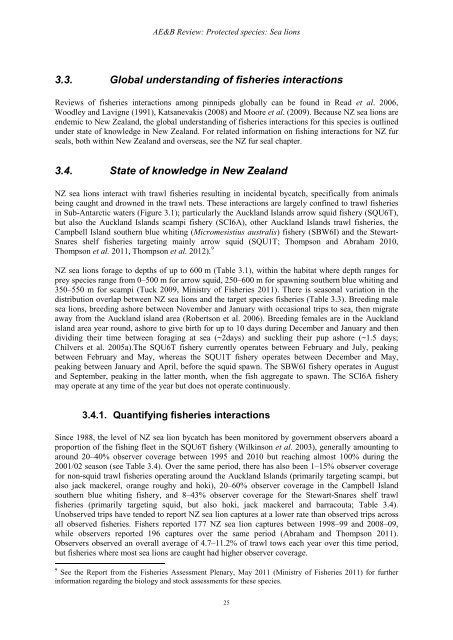Aquatic Environment and Biodiversity Annual Review 2012
Aquatic Environment and Biodiversity Annual Review 2012
Aquatic Environment and Biodiversity Annual Review 2012
Create successful ePaper yourself
Turn your PDF publications into a flip-book with our unique Google optimized e-Paper software.
AE&B <strong>Review</strong>: Protected species: Sea lions<br />
3.3. Global underst<strong>and</strong>ing of fisheries interactions<br />
<strong>Review</strong>s of fisheries interactions among pinnipeds globally can be found in Read et al. 2006,<br />
Woodley <strong>and</strong> Lavigne (1991), Katsanevakis (2008) <strong>and</strong> Moore et al. (2009). Because NZ sea lions are<br />
endemic to New Zeal<strong>and</strong>, the global underst<strong>and</strong>ing of fisheries interactions for this species is outlined<br />
under state of knowledge in New Zeal<strong>and</strong>. For related information on fishing interactions for NZ fur<br />
seals, both within New Zeal<strong>and</strong> <strong>and</strong> overseas, see the NZ fur seal chapter.<br />
3.4. State of knowledge in New Zeal<strong>and</strong><br />
NZ sea lions interact with trawl fisheries resulting in incidental bycatch, specifically from animals<br />
being caught <strong>and</strong> drowned in the trawl nets. These interactions are largely confined to trawl fisheries<br />
in Sub-Antarctic waters (Figure 3.1); particularly the Auckl<strong>and</strong> Isl<strong>and</strong>s arrow squid fishery (SQU6T),<br />
but also the Auckl<strong>and</strong> Isl<strong>and</strong>s scampi fishery (SCI6A), other Auckl<strong>and</strong> Isl<strong>and</strong>s trawl fisheries, the<br />
Campbell Isl<strong>and</strong> southern blue whiting (Micromesistius australis) fishery (SBW6I) <strong>and</strong> the Stewart-<br />
Snares shelf fisheries targeting mainly arrow squid (SQU1T; Thompson <strong>and</strong> Abraham 2010,<br />
Thompson et al. 2011, Thompson et al. <strong>2012</strong>). 9<br />
NZ sea lions forage to depths of up to 600 m (Table 3.1), within the habitat where depth ranges for<br />
prey species range from 0–500 m for arrow squid, 250–600 m for spawning southern blue whiting <strong>and</strong><br />
350–550 m for scampi (Tuck 2009, Ministry of Fisheries 2011). There is seasonal variation in the<br />
distribution overlap between NZ sea lions <strong>and</strong> the target species fisheries (Table 3.3). Breeding male<br />
sea lions, breeding ashore between November <strong>and</strong> January with occasional trips to sea, then migrate<br />
away from the Auckl<strong>and</strong> isl<strong>and</strong> area (Robertson et al. 2006). Breeding females are in the Auckl<strong>and</strong><br />
isl<strong>and</strong> area year round, ashore to give birth for up to 10 days during December <strong>and</strong> January <strong>and</strong> then<br />
dividing their time between foraging at sea (~2days) <strong>and</strong> suckling their pup ashore (~1.5 days;<br />
Chilvers et al. 2005a).The SQU6T fishery currently operates between February <strong>and</strong> July, peaking<br />
between February <strong>and</strong> May, whereas the SQU1T fishery operates between December <strong>and</strong> May,<br />
peaking between January <strong>and</strong> April, before the squid spawn. The SBW6I fishery operates in August<br />
<strong>and</strong> September, peaking in the latter month, when the fish aggregate to spawn. The SCI6A fishery<br />
may operate at any time of the year but does not operate continuously.<br />
3.4.1. Quantifying fisheries interactions<br />
Since 1988, the level of NZ sea lion bycatch has been monitored by government observers aboard a<br />
proportion of the fishing fleet in the SQU6T fishery (Wilkinson et al. 2003), generally amounting to<br />
around 20–40% observer coverage between 1995 <strong>and</strong> 2010 but reaching almost 100% during the<br />
2001/02 season (see Table 3.4). Over the same period, there has also been 1–15% observer coverage<br />
for non-squid trawl fisheries operating around the Auckl<strong>and</strong> Isl<strong>and</strong>s (primarily targeting scampi, but<br />
also jack mackerel, orange roughy <strong>and</strong> hoki), 20–60% observer coverage in the Campbell Isl<strong>and</strong><br />
southern blue whiting fishery, <strong>and</strong> 8–43% observer coverage for the Stewart-Snares shelf trawl<br />
fisheries (primarily targeting squid, but also hoki, jack mackerel <strong>and</strong> barracouta; Table 3.4).<br />
Unobserved trips have tended to report NZ sea lion captures at a lower rate than observed trips across<br />
all observed fisheries. Fishers reported 177 NZ sea lion captures between 1998–99 <strong>and</strong> 2008–09,<br />
while observers reported 196 captures over the same period (Abraham <strong>and</strong> Thompson 2011).<br />
Observers observed an overall average of 4.7–11.2% of trawl tows each year over this time period,<br />
but fisheries where most sea lions are caught had higher observer coverage.<br />
9 See the Report from the Fisheries Assessment Plenary, May 2011 (Ministry of Fisheries 2011) for further<br />
information regarding the biology <strong>and</strong> stock assessments for these species.<br />
25

















